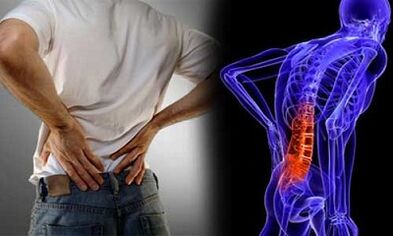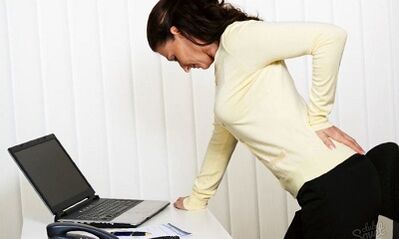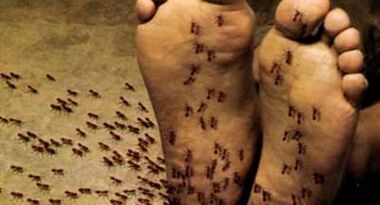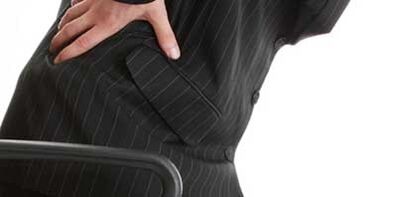You probably can't find a single adult who didn't know what "Lumbar Osteochondrosis" was.On average, every third of the third party, and sometimes more often, in life she had an episode of acute lower back, and every heel indicates that such problems are regularly emerging, and even a "source" of the hospital list.
However, explain in detail what happened for violation in the lower back, patients can usually not.Most of them have never been questioned, and treatment consists in the form of "injections", "massage", massage sessions usually help a period of several months to a year.
If you "ask" such a patient and start inquiring the diagnosis, you will suffer a little, it will declare that it is ill with "osteochondrose".What does this disease mean, compared to lumbar spine?
Osteochondrose of the lumbar region - a disease or "norm of life"?

First of all, you must say authoritatively: "Osteochondrosis" cannot hurt.And in any way, it cannot be manifested, because it is a process of dystrophy and degeneration of intervertebral discs, ie cartilage, consisting of the Fulp core and fibrous rings.The intervertebral disk is a cartilage, and is designed to work as a shock-absorbing "airbag", softening of vertical and angular accelerations - inhibition between neighboring vertebrae.
As you know, cartilage is deprived of nervous and vascular tissue, so the processes that are "clean in discs" simply cannot affect neighboring structures and do not reinforce in any way.A similar example in vertebroneurology are Kile Shomorlea, in which hernial protrusion is reliably covered with spongy bone tissue of the neighboring vertebrae.Intervertebral discs don't hurt.
Chondroza (suffix "-O" means an increase, increase), in this case - not exactly.This does not happen during the human life of growth and increasing cartilage.Here with fibrosis (cirrhosis) liver can be noticed that the mesh liver structure began to develop, to the detriment of the function.
And with chondrose (or osteochondrose), intervertal discs are just beginning to change their configuration, under the influence of multi-annual loads.
They cause pressure on neighboring vertebrates, because, according to Newton law, each action on static load gave birth to the exact same opposition or response to support.How is osteochondrose developing and what reason is this happening?
Causes of "Lumbar Osteochondrose"
Signs of osteochondrose of the lumbar region (accurately, intervective discs) can be found in the youth, especially with a variety of violations of the musculos.
Can be credited, for example:
- Congenital anomalies (different leg lengths);
- various types of straight feet (longitudinal, transverse);
- Deformation of the spinal column (scoliosis);
- Spondylolistz (sliding lower, lumbar vertebrae from sacral bone and back and back).
All of these diseases can cause or increase the shock load on the spinal column (for example, with straight legs, when the feet of the foot feet is declining), and with severe assymbalness, when the support function is systematically realized due to the load on the edge of the disk.
It was known that the experiments were found to be healthy and young cartilage, if they give them a burden on the entire surface, can withstand up to 2000 kg, and even greater for themselves.Of course, there is no such load in everyday life, but it can be increased to such values when the disc edge is exposed.
If the support area is 20 times less, and the disk will not be so healthy (for example, in old age), then exposure to 60-80 kg (for example, a slope in the slope) can cause disk destruction, which can be in the form of a protrusion or hernia.
It is an occurrence of protrusion or hernia that indicates that the disk is deformed, and even "crawled" from one or more.And around the disk, as you know, no idle.As soon as the disk starts to contact the nerves, adjacent ligaments and muscles, the consequences of osteochondrose appear: reflex pain and muscular-tonic syndromes that turn the patient around the neurologist, hand therapist and masseur.
Meanwhile, discs have a normal form and carry evenly, without extreme loads, then the osteochondrosis of the lumbar spine bothering the patient no more than usual, the gravity of the tooth, with whom criminals are well known.How are reflective pain syndromes manifest?
Symptoms and signs of complex lumbar osteochondrose

You have already noticed that we are the bridge "breeds: ordinary osteochondrose is completely inevitable the process of ordinary elastic intervertebral" seals "in a" reasonable man "type, because it moves vertically throughout life.And "osteochondrosis" that patients with acute recall pain are a complicated condition.
We may start, with the signs of compression of radicular compression.The signs of lumbar osteochondrose, of course, are connected with pain, due to the segmental zean spine, pressed by disk.In addition to pain, sensitive, engines and vegetate of trophetic disorders are possible.
Low pain in Osteochondrosi has the following characteristics:
1) rhymed pain.It is secondary, and continues according to the type of neuralgia, when the swollen nerve spine is very "violently" responding to the concussion.
The pain is sharp, sudden, shooting, piercing the lower back, can give up.The pain appears and is immediately enhanced, so it is called "lumbago", or "background".It is such a "zipper" that makes a person "stand up to Germany" because any movement leads to increased pain.
In addition, pain is amplified on the smallest cough, sneezing, strain, laughter - every situation in which swollen spine is shaking.
In the event that the spine is part of the sciatic nerve, the pain "shoots" through the butt in the posteal fosse and below, and it is called "Lumbar -algia."
2) muscle pain.There are great muscular massifs near the nerve spine.Often, in the spring and autumn "get up", and they are swollen, they become thick.The veny outflow is difficult in them, and ourselves are the source of pain.
This pain hurts, constant, not so harsh.This, on the contrary, intensifies not only with a sharp motion, but also with long-term in monotonous position (worsening blood supply).
- Sometimes such a myofascial syndrome appears after the worsening of the protrusion or hernia, when the sharp "hip" Hernie "massages" is a long time muscles and ligaments.
3) Engine disorders.Since the disc can clench not only sensitive, but also a motor spine, it is possible to develop peripheral paresis or even paralysis.With different levels of damage, the occurrence of weakness in legs (for example, weakness when climbing stairs in one hand), weakness in the foot, leading to damaged walking.
There is a hypotrophy muscle, one leg "loses weight".Such a pure engine, a painless disorder is rare, and remaining unnoticed, can lead to disability.

4) sensitive violations.They appear with pain, there are often even after the end of pain, instead of pain.They manifest stiffs, reducing the skin sensitivity by the type of "stripe", in the form of vertical stripes, feeling "crawling goosebumps" in the fingers and legs.
- Sometimes, with vegetative fiber impairment, symptoms combine with hyperhidrosis, skin cooling, hair and nail growth.
These are the loudest signs of complex lumbar osteochondrone that exist in the lumbar area.There are separate syndromes, for example, damage to the outer skin of thighs or damage to the horse, epiconus, pure radiculitis or muscular pear syndrome - but even their brief description will last too much time.
For patients, the above is the main signs for an application for neurologists.How can you "remove the deterioration with your own hands"?How to treat lumbar osteochondrose of the house?
What to do during the worsening of lumbar osteochondrose?
The basis of all treatment is Etiotropic therapy (removal of causes) and pathogenate treatment (influencing disease mechanisms).Symptomatic therapy joins it.
With top pain (caused by spine problems), things are like that:
- Elimination of causes is elimination of pressure by protrusion, hernia or cramping muscle on the nervous root;
- Impact on mechanisms is to remove muscle spasm, renovation of venous drain in the muscles, removal of edema nerve spine and the fight against inflammation;
- Elimination of symptoms (fight against pain, belittling, mobility limit) is performed by returning paragraph 2, from edema and inflammation, for example, mobility and relieve pain.
Resolve the protrusions and herninia
As a rule, he does not begin his treats in acute back pain.Almost always initially stops the pain syndrome, then, after the session of the massage and the treatment of the hand therapist, all symptoms go, and the operation is not required.
The question of surgical intervention arises with the advancement of weakness in the foot, and with severe unconscious pain within 2 months.In addition, the operation is needed when compressing the central channel at high levels in which the spinal moss is located or "Horse tail".
Treatment of lumbar osteochondrose, drugs
Treatment of lumbar osteochondrosis and its complications provide for the following measures.In sharp stages (first day - two):
- In order to reduce the muscular edema and spine, the sleepless diet and the amount of liquid used is indicated.You can even give a tablet of a slight diuretic drug that saves potassium.
- The carrying semi-transitional orthopedic corset is displayed, which saves the muscles from excessive movement.
- From the first days, there is a grease fat that contain NSAIDs, application of mortar, for example, "pepper".
- You can't warm your back in a sharp stage.With increasing inflammation, Edema increases.Therefore, all sorts of heating pads are prohibited.You can warm up, teach your own heat (woolen belt, fat heating), which are not added from outside, but, on the contrary, it is removed from depth.
- In the acute phase for osteochondrose, the lumbar region can be performed by the treatment of short-instorations in intramuscular "injections" of NSAI and muscular relaxants.This will help stop nerve tissue edema, eliminate inflammation and normalization of muscle tone.
In a subacute period, after overcoming maximum pain, "injection" should no longer be taken, and for example, attention should be paid to a restorative way, for example, modern vitamin preparations of the Groups "B".They were effective to renew weakened sensitivity, reduce stiffness and paresthesia.
Physiotherapy measures continue, time comes to conduct exercise therapy for osteochondrose of the lumbar spine.His task is to normalize blood circulation and muscle tone, when the edema and inflammation has already withdrawn, and muscle spasm has not yet been completely resolved.
Exercises for lumbar osteochondrosis of spine must be reported after light common heating, in the "warming muscles".
The main therapeutic factor is movement, not the degree of muscle contraction.Therefore, in order to avoid relapse, the use of cargo is not allowed, the cargo mat and gymnastic stick are used.With help, you can effectively return the strength of movement.
Rubbing fat, the use of iplicator Kuznetsov continues.Swimming, underwater massage, Sharko shower is shown.It is located in a phase of a muffled worsening that medication for home magnetotherapy and physiotherapy are shown.
Usually, the treatment does not last more than a week, but in some cases osteochondrosis can manifest such dangerous symptoms that the operation might be needed and urgent.
Complications of lumbar spine Osteochondrosis

First of all, about the condition when the disk hernia has become an independent fragment, and penetrated the central channel formed free retention.There can squeeze the nerves of the equestrian tail, and suddenly it can (right in the gym after the episode of acute pain) develop sharp weaknesses or paralysis in legs, the stiffness of the perineum.
After a few minutes, brutal pain in legs appears, and then - reflex delay in the urine or appearance of incontinence, immoditions.This emerged a horse syndrome, as a complication on Hernia's disk.In this case, urgent intervention is needed, a horse-tail nerve restorer restorer with their decompression.
However, other complications appear most often.More kileas and protrusion occurs with age, osteoporosis of vertebral appears, and mobility is simply declining and the risk of acute back pain increases.Such patients are sure to "take sick leave" several times a year, and are often treated in sanatoriums.
TREATMENT FORECAST
Osteochondrosis of lumbar spine, symptoms and treatment we have dismantled more, as we understood ourselves, mostly not in all the diseases, but simply by manifesting the inevitable aging and premature "shrinkage" of intervertebral disks.
Can humanity be fully spared from lumbar osteochondrose?This answer can be answered, but then we will have to master a different movement style: all our lives to move on all four, or, like Ichtyander, hovering in the depth of the ocean, they constantly move into childhood water.Then the axial, static load on intervertebral discs will disappear, and the signs of "Hondroze" will disappear.But the other problem will appear: in water, such a powerful design will become simply unnecessary, and will begin to change until it disappears, or will not significantly reduce.
As for personal, individual forecast for osteochondrose, it all depends on the time the person "decided to take the mind."If there is no pronounced destruction of intervertebral discs, protrusions, pounds and deformities, subject to healthy lifestyle and hygiene, physical activity cannot be known at full background background.
In the same case, when the hotspot "in the Lumbar region, for example, is in the form of Hernie, which occasionally narrow the nerve spine, then a person must take care of the awkward rotation and seasonal hypothermia, which usually causes the deterioration of osteochondrose spine.



































